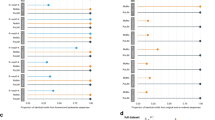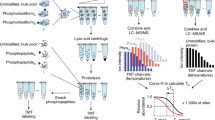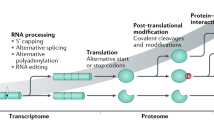Abstract
An organism’s entire protein modification repertoire has yet to be comprehensively mapped. N-myristoylation (MYR) is a crucial eukaryotic N-terminal protein modification. Here we mapped complete Homo sapiens and Arabidopsis thaliana myristoylomes. The crystal structures of human modifier NMT1 complexed with reactive and nonreactive target-mimicking peptide ligands revealed unexpected binding clefts and a modifier recognition pattern. This information allowed integrated mapping of myristoylomes using peptide macroarrays, dedicated prediction algorithms, and in vivo mass spectrometry. Global MYR profiling at the genomic scale identified over a thousand novel, heterogeneous targets in both organisms. Surprisingly, MYR involved a non-negligible set of overlapping targets with N-acetylation, and the sequence signature marks for a third proximal acylation—S-palmitoylation—were genomically imprinted, allowing recognition of sequences exhibiting both acylations. Together, the data extend the N-end rule concept for Gly-starting proteins to subcellular compartmentalization and reveal the main neighbors influencing protein modification profiles and consequent cell fate.
This is a preview of subscription content, access via your institution
Access options
Access Nature and 54 other Nature Portfolio journals
Get Nature+, our best-value online-access subscription
$29.99 / 30 days
cancel any time
Subscribe to this journal
Receive 12 print issues and online access
$259.00 per year
only $21.58 per issue
Buy this article
- Purchase on Springer Link
- Instant access to full article PDF
Prices may be subject to local taxes which are calculated during checkout





Similar content being viewed by others
References
Kelleher, N. L. A cell-based approach to the human proteome project. J. Am. Soc. Mass Spectrom. 23, 1617–1624 (2012).
Aebersold, R. & Mann, M. Mass-spectrometric exploration of proteome structure and function. Nature 537, 347–355 (2016).
Marino, G., Eckhard, U. & Overall, C. M. Protein termini and their modifications revealed by positional proteomics. ACS Chem. Biol. 10, 1754–1764 (2015).
Giglione, C., Fieulaine, S. & Meinnel, T. N-terminal protein modifications: bringing back into play the ribosome. Biochimie 114, 134–146 (2015).
Aksnes, H., Drazic, A., Marie, M. & Arnesen, T. First things first: vital protein marks by N-terminal acetyltransferases. Trends Biochem. Sci. 41, 746–760 (2016).
Kumar, M. et al. S-Acylation of the cellulose synthase complex is essential for its plasma membrane localization. Science 353, 166–169 (2016).
Jiang, H. et al. Protein lipidation: occurrence, mechanisms, biological functions, and enabling technologies. Chem. Rev. 118, 919–988 (2018).
Buddelmeijer, N. The molecular mechanism of bacterial lipoprotein modification–how, when and why? FEMS Microbiol. Rev 39, 246–261 (2015).
Hentschel, A., Zahedi, R. P. & Ahrends, R. Protein lipid modifications–more than just a greasy ballast. Proteomics 16, 759–782 (2016).
Resh, M. D. Covalent lipid modifications of proteins. Curr. Biol. 23, R431–R435 (2013).
Meinnel, T. & Giglione, C. Tools for analyzing and predicting N-terminal protein modifications. Proteomics 8, 626–649 (2008).
Hannoush, R. N. Synthetic protein lipidation. Curr. Opin. Chem. Biol. 28, 39–46 (2015).
Tate, E. W., Kalesh, K. A., Lanyon-Hogg, T., Storck, E. M. & Thinon, E. Global profiling of protein lipidation using chemical proteomic technologies. Curr. Opin. Chem. Biol. 24, 48–57 (2015).
Thinon, E. et al. Global profiling of co- and post-translationally N-myristoylated proteomes in human cells. Nat. Commun. 5, 4919 (2014).
Wright, M. H. et al. Validation of N-myristoyltransferase as an antimalarial drug target using an integrated chemical biology approach. Nat. Chem. 6, 112–121 (2014).
Wright, M. H., Paape, D., Price, H. P., Smith, D. F. & Tate, E. W. Global profiling and inhibition of protein lipidation in vector and host stages of the sleeping sickness parasite Trypanosoma brucei. ACS Infect. Dis. 2, 427–441 (2016).
Roberts, A. J. & Fairlamb, A. H. The N-myristoylome of Trypanosoma cruzi. Sci. Rep. 6, 31078 (2016).
Traverso, J. A., Giglione, C. & Meinnel, T. High-throughput profiling of N-myristoylation substrate specificity across species including pathogens. Proteomics 13, 25–36 (2013).
Bhatnagar, R. S., Ashrafi, K., Futterer, K., Waksman, G. & Gordon, J. I. Biology and enzymology of protein N-myristoylation. in: The Enzymes, Vol. XXI (Protein Lipidation) (Tamanoi, F. & Sigman, D. S., eds., pp. 241–286, Academic Press, San Diego, 2001).
Pierre, M. et al. N-myristoylation regulates the SnRK1 pathway in Arabidopsis. Plant Cell 19, 2804–2821 (2007).
Martinez, A. et al. Extent of N-terminal modifications in cytosolic proteins from eukaryotes. Proteomics 8, 2809–2831 (2008).
Boisson, B. & Meinnel, T. A continuous assay of myristoyl-CoA:protein N-myristoyltransferase for proteomic analysis. Anal. Biochem. 322, 116–123 (2003).
Yang, S. H. et al. N-myristoyltransferase 1 is essential in early mouse development. J. Biol. Chem. 280, 18990–18995 (2005).
Burnaevskiy, N., Peng, T., Reddick, L. E., Hang, H. C. & Alto, N. M. Myristoylome profiling reveals a concerted mechanism of ARF GTPase deacylation by the bacterial protease IpaJ. Mol. Cell 58, 110–122 (2015).
Gaudet, P. et al. The neXtProt knowledgebase on human proteins: 2017 update. Nucleic Acids Res. 45 D1, D177–D182 (2017).
Traverso, J. A. et al. Roles of N-terminal fatty acid acylations in membrane compartment partitioning: Arabidopsis h-type thioredoxins as a case study. Plant Cell 25, 1056–1077 (2013).
Zhou, F., Xue, Y., Yao, X. & Xu, Y. CSS-Palm: palmitoylation site prediction with a clustering and scoring strategy (CSS). Bioinformatics 22, 894–896 (2006).
Blanc, M. et al. SwissPalm: Protein Palmitoylation database. F1000Res 4, 261 (2015).
Hemsley, P. A., Weimar, T., Lilley, K. S., Dupree, P. & Grierson, C. S. A proteomic approach identifies many novel palmitoylated proteins in Arabidopsis. New Phytol. 197, 805–814 (2013).
Majeran, W., Le Caer, J.P., Ponnala, L., Meinnel, T. & Giglione, C.= Targeted profiling of A. thaliana sub-proteomes illuminates new co- and post-translationally N-terminal Myristoylated proteins. Plant Cell 30, 543–562 (2018).
Zha, J., Weiler, S., Oh, K. J., Wei, M. C. & Korsmeyer, S. J. Posttranslational N-myristoylation of BID as a molecular switch for targeting mitochondria and apoptosis. Science 290, 1761–1765 (2000).
Vilas, G. L. et al. Posttranslational myristoylation of caspase-activated p21-activated protein kinase 2 (PAK2) potentiates late apoptotic events. Proc. Natl Acad. Sci. USA 103, 6542–6547 (2006).
Martin, D. D. et al. Identification of a post-translationally myristoylated autophagy-inducing domain released by caspase cleavage of huntingtin. Hum. Mol. Genet. 23, 3166–3179 (2014).
Linster, E. et al. Downregulation of N-terminal acetylation triggers ABA-mediated drought responses in Arabidopsis. Nat. Commun. 6, 7640 (2015).
Arnesen, T. et al. Proteomics analyses reveal the evolutionary conservation and divergence of N-terminal acetyltransferases from yeast and humans. Proc. Natl Acad. Sci. USA 106, 8157–8162 (2009).
Bienvenut, W. V. et al. Comparative large scale characterization of plant versus mammal proteins reveals similar and idiosyncratic N-alpha-acetylation features. Mol. Cell. Proteomics 11, M111.015131 (2012).
Colaert, N., Helsens, K., Martens, L., Vandekerckhove, J. & Gevaert, K. Improved visualization of protein consensus sequences by iceLogo. Nat. Methods 6, 786–787 (2009).
Kremers, P. et al. Cytochrome P-450 monooxygenase activities in human and rat liver microsomes. Eur. J. Biochem. 118, 599–606 (1981).
Frottin, F. et al. MetAP1 and MetAP2 drive cell selectivity for a potent anti-cancer agent in synergy, by controlling glutathione redox state. Oncotarget 7, 63306–63323 (2016).
Bienvenut, W. V., Giglione, C. & Meinnel, T. SILProNAQ: a convenient approach for proteome-wide analysis of protein N-termini and N-terminal acetylation quantitation. Methods Mol. Biol 1574, 17–34 (2017).
Espagne, C., Martinez, A., Valot, B., Meinnel, T. & Giglione, C. Alternative and effective proteomic analysis in Arabidopsis. Proteomics 7, 3788–3799 (2007).
Evans, P. R. & Murshudov, G. N. How good are my data and what is the resolution? Acta Crystallogr. D Biol. Crystallogr 69, 1204–1214 (2013).
Adams, P. D. et al. PHENIX: a comprehensive Python-based system for macromolecular structure solution. Acta Crystallogr. D Biol. Crystallogr 66, 213–221 (2010).
Emsley, P., Lohkamp, B., Scott, W. G. & Cowtan, K. Features and development of Coot. Acta Crystallogr. D Biol. Crystallogr 66, 486–501 (2010).
Schüttelkopf, A. W. & van Aalten, D. M. PRODRG: a tool for high-throughput crystallography of protein-ligand complexes. Acta Crystallogr. D Biol. Crystallogr 60, 1355–1363 (2004).
DeLano, W.L. The PyMOL Molecular Graphics System. http://www.pymol.org (2002).
Suckau, D. et al. A novel MALDI LIFT-TOF/TOF mass spectrometer for proteomics. Anal. Bioanal. Chem. 376, 952–965 (2003).
Vizcaíno, J. A. et al. The PRoteomics IDEntifications (PRIDE) database and associated tools: status in 2013. Nucleic Acids Res. 41, D1063–D1069 (2013).
Acknowledgements
This work was funded by Agence Nationale de la Recherche (ANR-2010-BLAN-1611-01) and Fondation ARC (SFI2011120111203841). The team benefits from the support of the LabEx Saclay Plant Sciences-SPS (ANR-10-LABX-0040-SPS). C.D., B.C., and S.C. were supported by postdoctoral fellowships (CNRS). We thank W. Majeran and C. Micalella for initial help with sample preparation and in vitro assays and all members of the group for stimulating discussions. The 2016 innovative experimental training Master class students hosted in the Gif laboratory actively contributed to early crystallographic attempts of one NMT complex. C. Duyckaerts (APHP) and Hopital Pitié Salpêtrière (Université Pierre et Marie Curie, Paris) kindly allowed access to human tissue samples from Neuro-CEB (http://www.neuroceb.org/) and M.-A. Loriot and A. Al Ali to sample preparation. J. Bignon (CNRS, Gif) allowed access to human cell culture facility. This work used the facilities and expertise of the SICaPS mass spectrometry platform at I2BC (Gif). We thank ESRF staff for help with data collection.
Author information
Authors and Affiliations
Contributions
C.D. performed NMT cloning, purification, and structural analysis. B.C. and S.C. performed in vitro assays. W.V.B. and J.P.L.C performed mass spectrometry measurements and analysis. C.L.E. and J.-M.S. built the SVM classifiers. C.G. and T.M. designed the research, supervised the overall project, analyzed the data, and wrote the manuscript.
Corresponding authors
Ethics declarations
Competing interests
The authors declare no competing interests.
Additional information
Publisher’s note: Springer Nature remains neutral with regard to jurisdictional claims in published maps and institutional affiliations.
Supplementary information
Supplementary Text and Figures
Supplementary Tables 1–3, Supplementary Figures 1–5
Supplementary Dataset 1
Data associated with the 2k macroarray and the Arabidopsis thaliana myristoylome
Supplementary Dataset 2
Complete human myristoylome
Supplementary Dataset 3
Protein N-Gly termini isolated from humans
Supplementary Dataset 4
Protein N-Gly termini from Arabidopsis thaliana
Rights and permissions
About this article
Cite this article
Castrec, B., Dian, C., Ciccone, S. et al. Structural and genomic decoding of human and plant myristoylomes reveals a definitive recognition pattern. Nat Chem Biol 14, 671–679 (2018). https://doi.org/10.1038/s41589-018-0077-5
Received:
Accepted:
Published:
Issue Date:
DOI: https://doi.org/10.1038/s41589-018-0077-5
This article is cited by
-
Protein lipidation in health and disease: molecular basis, physiological function and pathological implication
Signal Transduction and Targeted Therapy (2024)
-
Protein lipidation in cancer: mechanisms, dysregulation and emerging drug targets
Nature Reviews Cancer (2024)
-
Identification of potent and selective N-myristoyltransferase inhibitors of Plasmodium vivax liver stage hypnozoites and schizonts
Nature Communications (2023)
-
The putative myristoylome of Physcomitrium patens reveals conserved features of myristoylation in basal land plants
Plant Cell Reports (2023)
-
Local and substrate-specific S-palmitoylation determines subcellular localization of Gαo
Nature Communications (2022)



